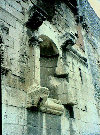


Above: inside and outside views of the "Bronze Gate", and Fischer von Erlach's reconstruction of the (southern) "Iron Gate", from his Entwuerff einer historischen Architektur, Vienna 1721, Tafel XI
The walls and gates which ensured Split's safety are stil largely intact, the southern walls being the location for a regular market. The height of the walls and the strength of the towers makes it clear that Split is no bijou make-believe residence - an impression underlined when one passed through a landward gate, not directly into the city, but into a square vestibule which represents a second point of defence should the gate itself (protected by the guard-towers) be breached.
But the east and west gates are secondary to the north one, which is on the main axis for approaching the palace:
Above: a flanking view of the North Gate, a front view, and a closeup of the large lintel block and relieving arch (surely largely decorative?) above it.
Hence it is larger and more decorated, with niches for statues flanking the extravagant arch above the equally extravagant lintel block, and a row of dummy arches above - a kind of populated blind arcade, for here also there are three niches for statues. Originally the set-up would have been even more splendid, for the octagonal flanking towers do not survive.
Nevertheless, the following photograph shows the vestibule inside the North Gate, where visitors would one have been examined, and where they could be stopped by the guards:
Flanking the east gate, and inside it, were guard rooms: the
modern windows punctured in the facade show that this now
provides a dry and even a prestigious address - accommodation in
the Aurelian walls of Rome still exists, and is highly prized!
It is the arcading at
Less splendid than the North Gate, but similar in design, the
East Gate has the same massive entablature block with relieving
arch, plus flanking niches for statues; but the upper storey,
instead of holding yet more statues, was perhaps originally just
arcaded as it is today:
A more distant view makes clear the lightness and airiness of
the arcading on this side of the city (with the market in the
foreground:
If Wilkes (1986, 27) is correct in stating that this
appellation is first recorded only in 1553 (and the "bronze" and
"iron" gates, by extension, at the same time), then this
introduces us to two common features of Renaissance admiration
for the antique, namely the tendency to make things much richer
than they were (surely, the gate never was "golden"), and to
make things into sets.
From here you may go to any of the following screens:
The Introductory Page;
The Colonnaded Streets;
Comparisons with Split's Architecture;
Diocletian as Builder;
The Emperor's Apartments;
The Great Hall & Peristyle Complex;
The Emperor's Mausoleum;
Is Split palace or chateau?;
The Temple;
A short description of the Tetrarchy;
The Bibliography;
My Biography;
The technology I've used;
A Short Research Paper.